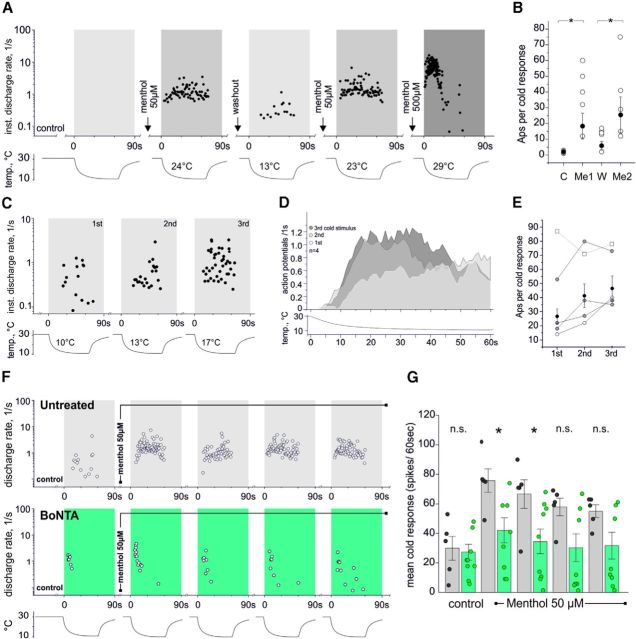Figure 8.
Agonist exposure increases cold sensitivity in CMC fibers and inhibition of vesicle exocytosis with BoNTA leads to increased adaptation of TRPM8-mediated responses. A, Original recording from a temperature-insensitive mechanosensitive C fiber recorded from the saphenous-nerve innervation territory of a C57BL/6 mouse. Instantaneous discharge rates in response to repeated menthol application (50 and 500 μm) and subsequent cooling of the receptive field are shown. Menthol produces de novo, partly reversible and reproducible sensitization to cold (interstimulus interval and drug wash-in 240 s). Bottom, Time course of cold stimulus and temperature thresholds of activation. B, Quantification of the menthol effect on cold sensitization as increase in response magnitude (action potentials (APs) per 60 s cold stimulus; n = 5). Control cold stimulus marked with “C,” “Me1,” and “Me2”: 50 μm menthol application to receptive field; “W”: drug wash-off (p = 0.04, Wilcoxon matched pairs test). C–E, Repeated cold stimulation can increase cold response of menthol-sensitive cold nociceptors. C, D, Original recording from a CMC fiber showing instantaneous discharge rates in response to repeated 60 s cooling pulses (C) and averaged responses of 4 fibers (D). Repeated activation of the fiber by cold increased each subsequent response to cooling. Bottom, Time course of cold stimulus and temperature thresholds of activation. Interstimulus interval 3–4 min. E, Magnitude of consecutive cold responses counted as action potentials (APs) per 60 s cold stimulus. CMC fibers with large cold response (white square, dashed line) desensitize. Gray circles represent individual data points. Black circles represent data points with SEM (mean of 4 fibers). Open white circles represent recording plotted in C. F, G, BoNTA pretreatment prevents menthol-induced sensitization to cooling in most CMC fibers. F, Original traces of CMC fibers recorded from (top) an untreated C57BL6 mouse skin–nerve preparation and (bottom) from a BoNTA-pretreated skin shown as instantaneous discharge rates in response to a 60 s cooling stimulus. Menthol 50 μm was present throughout cold stimuli 2–5. Bottom, Temperature time course. G, Bar chart illustrating average cold responses (amount of action potentials per cold stimulus of 60 s) of CMC fibers from untreated skins (gray, n = 5) and BoNTA-treated skins (green, n = 9). Circles represent individual data points. The majority (6 of 9) of CMC fibers from BoNTA-pretreated skins showed poor cold sensitization after menthol treatment. Interstimulus interval 180–240 s. *p < 0.05 (Mann–Whitney U test).

